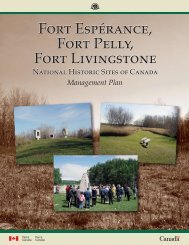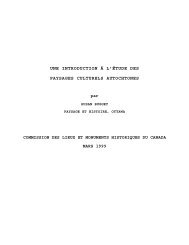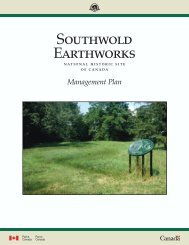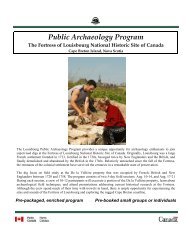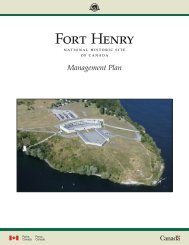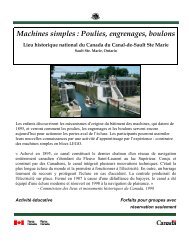Linear Mounds National Historic Site of Canada
Linear Mounds National Historic Site of Canada
Linear Mounds National Historic Site of Canada
Create successful ePaper yourself
Turn your PDF publications into a flip-book with our unique Google optimized e-Paper software.
2<br />
This is true despite the ravages <strong>of</strong> time, early<br />
relic collectors and many years <strong>of</strong> active farm<br />
cultivation.<br />
Administratively, <strong>Linear</strong> <strong>Mounds</strong> is the<br />
responsibility <strong>of</strong> the Manitoba Field Unit<br />
headquartered in Winnipeg. It is a nonoperational<br />
site having no on-site staff and<br />
no visitor services. As a result there has been<br />
no dedicated operational budget. However,<br />
this status does not diminish Parks <strong>Canada</strong>’s<br />
obligation to protect the site, communicate its<br />
importance and to engage others in achieving<br />
these objectives while respecting the spiritual<br />
nature <strong>of</strong> the site. This management plan<br />
describes the long-term vision for the protection,<br />
presentation and use <strong>of</strong> this important, yet<br />
potentially vulnerable place.<br />
1.1 <strong>National</strong> <strong>Historic</strong> <strong>Site</strong>s <strong>of</strong> <strong>Canada</strong><br />
<strong>Linear</strong> <strong>Mounds</strong> belongs to a nation-wide<br />
network <strong>of</strong> protected heritage areas, which<br />
include <strong>National</strong> Parks, <strong>National</strong> Marine<br />
Conservation Areas and <strong>National</strong> <strong>Historic</strong><br />
<strong>Site</strong>s. 1 <strong>National</strong> Parks and <strong>National</strong> Marine<br />
Conservation Areas are established as<br />
representative examples <strong>of</strong> distinctive land and<br />
marine environments while <strong>Canada</strong>’s <strong>National</strong><br />
<strong>Historic</strong> sites are commemorated because they<br />
represent thousands <strong>of</strong> years <strong>of</strong> human history<br />
and hundreds <strong>of</strong> years <strong>of</strong> nation building. These<br />
special places are part <strong>of</strong> the inheritance <strong>of</strong> all<br />
Canadians and are recognized under law as<br />
being <strong>of</strong> national importance to the history<br />
<strong>of</strong> our country. Parks <strong>Canada</strong> has several very<br />
important roles; both as guardians and as<br />
storytellers for these special places. These roles<br />
are defined in the following objectives for<br />
<strong>National</strong> <strong>Historic</strong> <strong>Site</strong>s: 2<br />
• foster knowledge and appreciation <strong>of</strong><br />
<strong>Canada</strong>’s past through a national program <strong>of</strong><br />
historical commemoration;<br />
• ensure the commemorative integrity <strong>of</strong><br />
national historic sites administered by Parks<br />
<strong>Canada</strong> by protecting and presenting them<br />
for the benefit, education, and enjoyment <strong>of</strong><br />
this and future generations, in a manner that<br />
respects the significant and irreplaceable<br />
legacy represented by these places and their<br />
associated resources;<br />
• encourage and support the protection<br />
and presentation by others <strong>of</strong> places <strong>of</strong><br />
national historic significance that are not<br />
administered by Parks <strong>Canada</strong>.<br />
1.2 Commemorative Integrity<br />
Commemorative Integrity is the corner-stone <strong>of</strong><br />
Parks <strong>Canada</strong>’s Cultural Resource Management<br />
Policy. It is a values-based concept created by<br />
Parks <strong>Canada</strong> to evaluate and manage <strong>National</strong><br />
<strong>Historic</strong> <strong>Site</strong>s. It is used to report to Parliament<br />
and the Canadian public on their condition.<br />
A <strong>National</strong> <strong>Historic</strong> <strong>Site</strong> has commemorative<br />
integrity when:<br />
• the resources directly related to the reasons<br />
for designation as a national historic site are<br />
not impaired or under threat;<br />
• the reasons for designation as a national<br />
historic site are effectively communicated to<br />
the public;<br />
• the site’s heritage values are respected in all<br />
decisions and actions affecting the site.<br />
The values <strong>of</strong> a national historic site that relate<br />
to the reasons for its designation constitute<br />
its commemorative intent. This describes the<br />
specific reason a place has been deemed to be<br />
nationally significant. The commemorative intent<br />
for a national historic site comes directly from<br />
1<br />
154 <strong>of</strong> the more than 900 <strong>National</strong> <strong>Historic</strong> <strong>Site</strong>s are administered by Parks <strong>Canada</strong>. <strong>Linear</strong> <strong>Mounds</strong> NHSC is one <strong>of</strong> them. The remainder<br />
are administered by other federal departments, provinces or territories, or are privately owned.<br />
2<br />
Parks <strong>Canada</strong> <strong>National</strong> <strong>Historic</strong> <strong>Site</strong>s Policy<br />
linear mounds national historic site <strong>of</strong> canada<br />
Management Plan



